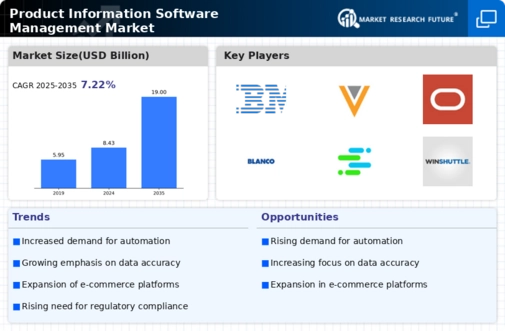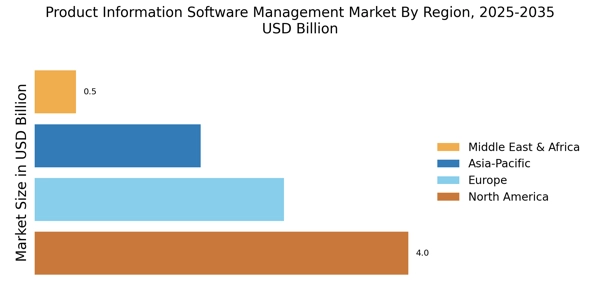Expansion of E-commerce Platforms
The Product Information Software Management Market is significantly influenced by the rapid expansion of e-commerce platforms. As online shopping continues to gain traction, businesses are compelled to optimize their product information to remain competitive. Data suggests that e-commerce sales are expected to reach over 6 trillion dollars by 2024, underscoring the necessity for effective product information management. Companies are increasingly adopting software solutions that facilitate the seamless integration of product data across various e-commerce channels. This integration not only enhances the visibility of products but also ensures that customers have access to accurate and up-to-date information, which is essential for driving sales in the digital marketplace. The expansion of e-commerce is likely to propel further growth in the product information management sector.
Integration of Advanced Analytics
The Product Information Software Management Market is witnessing a trend towards the integration of advanced analytics into product information management systems. Organizations are increasingly recognizing the value of data-driven decision-making and are seeking solutions that provide insights into product performance and customer behavior. By leveraging analytics, businesses can identify trends, optimize product offerings, and enhance marketing strategies. This shift towards data analytics is likely to enhance the effectiveness of product information management systems, enabling organizations to make informed decisions that drive growth. As the market evolves, the integration of advanced analytics is expected to become a key differentiator for companies looking to gain a competitive edge in the product information management landscape.
Regulatory Compliance and Standards
The Product Information Software Management Market is also shaped by the increasing need for regulatory compliance and adherence to industry standards. As businesses operate in diverse markets, they must navigate various regulations concerning product information disclosure and labeling. Compliance with these regulations is critical to avoid legal repercussions and maintain brand reputation. Consequently, organizations are investing in product information management solutions that facilitate compliance by ensuring that product data is accurate, complete, and readily accessible. This trend is particularly evident in industries such as food and beverage, pharmaceuticals, and consumer goods, where regulatory scrutiny is high. The focus on compliance is expected to drive demand for sophisticated product information management systems that can adapt to changing regulations.
Increased Focus on Customer Experience
In the Product Information Software Management Market, there is a growing emphasis on enhancing customer experience. Companies are increasingly aware that accurate and comprehensive product information is crucial for attracting and retaining customers. Research indicates that 70% of consumers are more likely to purchase from brands that provide detailed product information. This trend is prompting businesses to adopt advanced product information management systems that enable them to deliver consistent and engaging product content across multiple platforms. By leveraging these systems, organizations can ensure that customers receive the right information at the right time, ultimately leading to higher conversion rates and customer satisfaction. The focus on customer experience is likely to continue driving investments in product information management solutions.
Rising Demand for Digital Transformation
The Product Information Software Management Market is experiencing a notable surge in demand as organizations increasingly prioritize digital transformation initiatives. Companies are recognizing the necessity of streamlining their product information processes to enhance operational efficiency and improve customer experiences. According to recent data, the market is projected to grow at a compound annual growth rate of approximately 12% over the next five years. This growth is driven by the need for businesses to adapt to rapidly changing consumer preferences and technological advancements. As a result, organizations are investing in robust product information management solutions to centralize and manage their product data effectively, thereby fostering better collaboration across departments and ensuring consistency in product information across various channels.


















Leave a Comment